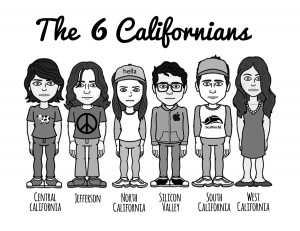Splitting California into six unrealistic
Let’s face it: No one wants to get divorced. It’s complicated and messy.
Yet that hasn’t stopped Silicon Valley venture capitalist Tim Draper from attempting to do just that to California. If his proposal to split California into six separate states can reach 807,615 signatures by July 14, the decision will be placed on the ballot in November, according to Time. Though California Sec. of State Debra Bowen announced that Draper could start collecting signatures for the plan, such a ridiculous proposal underestimates the difficulty behind taking on the endeavor of adding five states to the Union.
Calling California’s current state “ungovernable,” according to Time, Draper’s proposal would essentially solve the problem through the division of the state into six new governments. Under Draper’s proposal, California would be broken up into six individual states: Central California, Jefferson, North California, Silicon Valley, South California and West California. San Diego and Orange County would merge to create South California. Los Angeles would join Santa Barbara and claim the southern coast to form West California. Central California would consist of the vast farm area near Bakersfield and Fresno. The tech giants in San Francisco and San Jose would come together to form the aptly named Silicon Valley. The remaining two states would split the northern part of California into North California and Jefferson.
Draper argues that such a solution would alleviate California’s governing issues over such a large state, but the separation of the state into six new ones would also cause new issues entirely. Though splitting up the state would allow the more regional governments to better focus on the concerns of the individual area, more focus on individual constituents wouldn’t necessarily translate to easier governance. For example, the state would have to individually deal with how to respond to the statewide water crisis. Californians can already foresee difficulty allocating limited resources between one state under one government, let alone solving it under six.
What’s more, splitting California would only create more economic disparity. Silicon Valley would have the highest per-capita income in the United States, while Central California would become the poorest state in the country. Silicon Valley alone would become independent from the less economically productive regions of California, taking with it all of the state’s wealthy tech industry,an industry that would no longer have to deal with outside problems such as a poor education system or inferior state-funded infrastructure.
Furthermore, the formation of six states wouldn’t just require federal approval — which is nearly impossible to get — but it would also call for the elections of new congressional representatives to represent the newly formed states in Washington, D.C.
This isn’t the first time someone has called for a split of the Golden State. There was a bill to split California into two states in 1859, but Congress barred its passage due to the Civil War. In October, tech entrepreneur Balaji Srinivasan called for the secession of California from the union, arguing that the Silicon Valley needed to be relieved of governmental constraints on technology.
Such attempts, similar to the petition last January for Texas to secede from the union, have come and failed. This petition is no different.
Amanda Kim is a freshman majoring in creative writing.



What if only one state remained as part of the USA and the other five became independent nations?